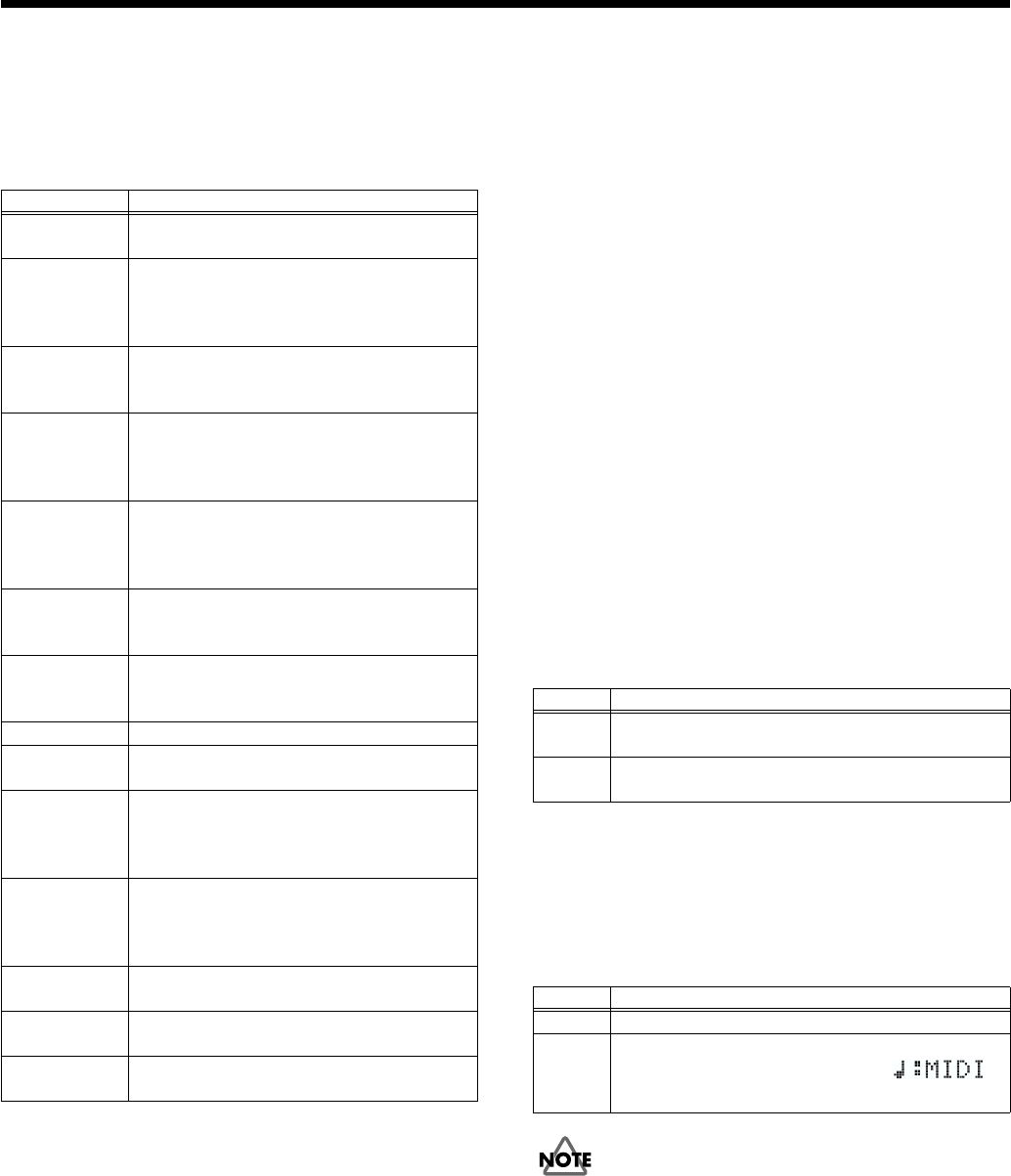
66
Detailed Settings for Each Function (EDIT)
Assigning Functions to Control Pedal
Ctrl Pdl Assign
This setting determines the function of the pedal switches or
expression pedals (such as the optional EV-7) that are
connected to the CONTROL PEDAL jacks on the rear panel.
*1 Stopping the rotation of the tone wheels
(Wheel Brake)
Throughout the history of rock organ, a wide range of
performers have developed unique effects and used
them in their music. The VR-760 features the wheel
brake as one of these characteristic effects.
It is possible to stop the rotation of the tone wheels of
the organ. This produces an unexpected result, whereby
the pitch of the organ voice gradually falls until the
sound ceases entirely.
The technique of stopping the tone wheel rotation was
occasionally used by performers on tone wheel organs.
Since the amp of a tone wheel organ was an analog
circuit that used vacuum tubes, the sound was still
audible for a time after the power was turned off.
However, when the power was turned off, the tone
wheels would begin slowing down, and you would
hear the pitch continue to fall.
Setting the Organ’s Quick Firing
Keyboard Function
Quick Firing (ON/OFF)
You can make settings for the organ’s Quick Firing function.
Setting this to Off cancels Quick Firing. Although this results
in poorer performance of glissando and rapid keyboard runs,
it prevents mostly the rebounding effect when the keys are
released.
Setting the Keyboard Video Switching
During V-LINK
V-Link KBD (ON/OFF)
You can set whether the eight lowest keys are used for
switching video clips or for producing sounds when the V-
LINK function is enabled.
Changing the Clock (Timing) Source
Clock Source (INT/MIDI)
You can control the tempo from an external MIDI device. Set
this to MIDI when synchronizing to the clock (tempo) of an
external MIDI device.
The tempo cannot be set if Clock Source is set to MIDI
without there being any external MIDI device connected.
This can result in Rhythms (p. 52) not sounding, and may
change the manner in which certain effects are applied.
Value Explanation
ROTARY
SLW/FST
This switches the organ part’s rotary
SLOW and FAST settings.
ROTARY
SPEED
You can freely set the speed of the organ
part’s rotary effect to any speed between
“slow” and “fast.” This works well when
you have an expression pedal connected.
ROTARY
BRAKE
This has the same effect as switching the
organ part rotary effect’s [BRAKE] button
on or off.
REGIST INC This switches you through the
registrations. The VR-760 goes through the
registrations, switching one registration
each time the pedal is pressed.
REGIST DEC This switches you through the
registrations. The VR-760 goes back
through the registrations, switching one
registration each time the pedal is pressed.
ORGAN
OVERDRIVE
This controls the depth of the overdrive
effect. This works well when you have an
expression pedal connected.
ORGAN
WHEEL BRK
This turns the organ’s wheel brake effect
(*1) on. After the pedal is released, the
sound gradually returns to normal.
PIANO SOFT This applies the piano’s soft pedal effect.
PIANO
SOSTENUTO
This applies the piano’s sostenuto pedal
effect.
PIANO
OCTAVE
This effect has the same function as the D
Beam OCTAVE (p. 49). This works well
when you have an expression pedal
connected.
PIANO
PEDAL WAH
This sets Pedal Wah as the wah type used
when Wah is selected as the piano’s MFX
effect. This works well when you have an
expression pedal connected.
SYNTH
GLIDE
This effect has the same function as the D
Beam GLIDE (p. 49).
RHY START-
STOP
This controls starting and stopping of the
Rhythm.
SEQ START-
STOP
When using MIDI, this controls starting
and stopping of the connected sequencer.
Value Explanation
ON The eight lowest keys at the far left are used for
switching videos.
OFF This disables the keys’ video switching function.
All keys are used for performing.
Value Explanation
INT Synchronized to the internal clock.
MIDI Synchronized to the external MIDI device’s clock.
The tempo indication changes to “ ”
for each screen.


















